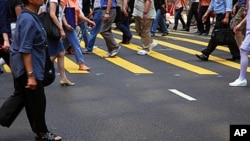The vast majority of Americans live in cities and urban life carries special health risks. Overcrowding leads to greater stress, which can lead to violence, according to Dr. Jo Boufford, president of the New York Academy of Medicine. And the complexity of cities makes them harder to navigate, which can lead to, or complicate, mental illness. City air is often polluted, and that can cause respiratory problems.
"All of those things play out in an urban environment in ways they don’t play out outside of cities, and they have an effect on people’s health, on people’s well being and on daily life," says Boufford. "But the real thing that runs through higher incidence of disease is largely poverty. That’s the bottom line."
The fact that a high proportion of urban residents are poor, poses special challenges for health professionals, who gathered recently at a National Urban Health Conference in New York. Health workers, academics and community activists met to share strategies for delivering quality health care to the urban poor.
Many people from the business world also attended the urban health conference. Employers who buy health insurance for their workers must pay higher premiums when more employees become sick. That cuts into profits. That’s why many employers offer preventative care.
"They provide health education opportunities for their own employees. Many of them provide opportunities ‘in-house’ for people to stop smoking," Boufford says. "They provide programs for people who feel they may be depressed or they have a substance abuse problem to get help, weight-loss programs, exercise programs, giving people a break in lunch hour to get out into the community and walk. So the return on investment is pretty clear at this point."
Obesity - a condition which can lead to diabetes, cancers and cardiac and respiratory problems - is epidemic in America’s cities. The Centers for Disease Control reports that more than half of New York African-Americans are obese. Javier Lopez, director of New York’s Strategic Alliance for Health, says the problem is especially severe among children in minority neighborhoods.
He believes fatty, highly-processed foods are partly to blame, but so is lack of exercise. He says that some of New York City’s educational policies for example, such as mandatory standardized testing, don’t help. When there is an open hour in a school day schedule, teachers often choose to fill it with academic drilling rather than physical education.
"So then you have to look at opportunities outside of the school day for physical activity. You have more bike lanes, for instance, in some urban settings now. So now you have to think about what programs are going to bring young people use those bike lanes," says Lopez. "You have to think about what bike-sharing programs are available in urban settings and thinking outside the box, using the landscape to be more effective for physical activity."
Lopez says that his obesity prevention work focuses on adults as well as children.
"For adults, the opportunity lies in educating on the availability of free and inexpensive programs. A lot of community centers offer free exercise classes that are readily available for folks. It’s just that a lot of the advertising and marketing for some of those programs need to be bulked up so more people can take advantage of them."
Better health education is key, says Dr. Aubrey Clark, a Harlem Hospital Center cardiologist. He led a panel at the conference on atherosclerosis. That’s a clogging of the arteries linked to stress, poor diet and other factors which can lead to diabetes, heart attack, stroke and other health issues.
"In terms of an institution, the education would involve outreach, screening in the communities, symposia and other outreach-type conferences to reach different organizations within the community, and inviting community members to functions such as this," says Clark. "On the clinical level, we want to make sure we have a multidisciplinary team approach to our patients, not only when they are acutely ill and hospitalized but to prepare them upon discharge to make sure they know what they are responsible for in terms of making sure that their health is as best as they can have it."
Boufford adds that health education is actually a two-way street between health providers and the communities they serve. This can be difficult in urban communities where many illegal immigrants live. They fear that visibility may lead to deportation. But in the case of outreach to the elderly by the New York Academy of Medicine and its partners, the efforts are bearing fruit.
"What do they say makes it easier or harder to live in the city?" says Boufford. "The kinds of things they raise are crossing the street, 'The streetlights are too fast. I can’t get across the street.’ ‘The sidewalks have pits or holes in them.’ ‘I can’t come out at night.’ ‘I can’t sit down when I go to a local business.’ These are simple things to solve and part of our initiative is to help do that."
Many participants at the National Urban Health Conference said they gained both knowledge and encouragement from the gathering. But most agreed that the challenges facing health care providers in America’s cities will continue to grow in the decades to come.










